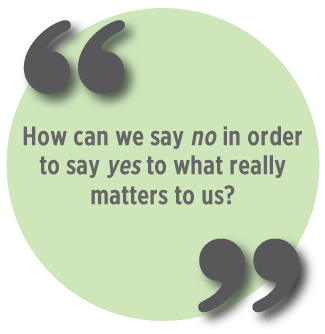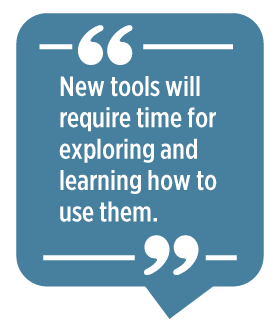
Effective time management is one area in which we believe teachers, coordinators, and program administrators must work hard. Why is effective time management important? And why is it important to manage our time in a 21st-century style?
Ours is an era of information overload and digital bombardment. Especially after 2020, we can say change is not only constant but also inevitable. We need to be flexible and able to adapt our teaching, programs, and assessments to new conditions. However, one thing remains unchanged: time. We have the same 24 hours to complete our duties and as Barker (2021) very well states, “…once you give up on doing everything, you can actually complete something that matters.”
So, how can we manage time in a 21st-century style? We would like to share some frameworks and some tech tools that may be useful to increase your productivity and avoid the feeling of burnout that we sometimes experience as educators.
Turning to Theory for Solutions
The first thing we need to reflect upon is what we do with our time. Barker (2021) argues that “the more you try to control time, the more stressed you feel. Accept limitations, realize you will not have time for it all, and focus on what matters. Only then can you feel relaxed.”
So, first things first, we must be selective about what projects, activities, and even thoughts absorb our time. This forces us to make difficult choices and be ready to say “no,” which is always tough. How can we say “no” in order to say “yes” to what really matters to us?
Barker’s Approach
Barker (2017), on his blog “Barking Up The Wrong Tree,” shares six secrets to say no without feeling guilty:
- Notice and identify the “no moments”: Reflect on all the times in which people say “no” to requests. For some reason, the times when we said “no” and someone got angry stick to our memory and are the ones that make us say “yes” at other times. So, watch your interactions with your students and with your colleagues and you will gain a better and more realistic perspective.

- Buy time: This means giving yourself some waiting time to allow you to make a sound decision. This might make a huge difference and prevent you from engaging in giving extra time to a student's or colleague’s request that is not crucial. Consequently, phrases like “I need to check my calendar; I’ll get back to you” will give you the time you need to decide what to do.
- Have a policy: Establish clear boundaries and respect them. It will make you feel less guilty because the decision is not personal. Therefore, there is less chance that your students or colleagues will feel personally rejected if this is a clear “rule” you live by.
- Be a broken record: Sometimes people need to hear “Sorry, I can’t” more than once to really listen to what you are saying. If you keep repeating the same and don’t allow yourself to get caught up in looking for arguments, the person will probably end up understanding you cannot help. This is especially true when dealing with students, who can keep insisting in the hope of getting the reply they wish.
- Use a “Relation Account”: Being a broken record may not be the best technique to use with colleagues. However, sometimes adults, and especially educators, understand empathy a bit better; using a line like: “If I helped you, I’d be letting others down” can really help.
- Make a counteroffer: This offers the possibility of valuing the person, the project, and your own time. Of course, this is not always an option, but consider whether you might offer an alternative, or perhaps whether you might even know someone else who can help the person.
Allen’s Methodology
Once we have decided what we want to dedicate our time to, we need to consider how to organize those tasks and projects. To do that, one tool that can be of help is a technique from Allen’s (2001) methodology. The objective is to follow a process that will help organize the things we have to do before engaging in actually doing them.
Step 1: Capturing
To begin with, “capture” everything that crosses your mind, and everything that gets to your email inbox. Include everything you need to correct, grade, plan, and design. Also, consider all the creative ideas you want to implement sometime in the future. Nothing is too big or too small at this capturing stage.Step 2: Processing
This means transforming all items into clear and concrete action steps. Consider that when processing the items, we need to decide whether they will be part of a project, if we need to take immediate action, or if we will leave them for later:
- First, ask, “Is this task actionable?”
-
If it is not, we may want to discard it, or leave it for reference or for some other time in the future.
-
If it is actionable, then we process it—but, the question is when. If we can do it in less than 2 minutes, we just do it! It will clear our to-do list of unnecessary items.
-
If it will take more than 2 minutes, we delegate it or defer it.
-
If we are deferring it, we will need to decide whether we add it to our calendar and establish a due date, or if we add it to today’s to-do list.
This practical method will become more useful with practice, and it is definitely worth the effort.
Step 3: Organizing
Organizing means putting everything in the right place. Here, we need to set dates in our calendar for both one-time and recurring activities. Also, we should ask ourselves some questions:
- Do we need to do this task?
-
Can we delegate it to someone else? (Sometimes, we can be very creative when delegating tasks. For instance, if you need cutouts for your next class, can this be part of the activity in class and have students cut the papers? Can you have your 10-year-old help you out?)
-
Are the cutouts really necessary? (This is the most important question.)
We also need to prioritize our activities to make sure if we run out of time, the most important activities will be completed.
Step 4: Reviewing
Reviewing our list of tasks is important to avoid ending up with never-ending to-do lists that we cannot manage to finish.Step 5: Engaging
And finally, engage. And enjoy! Why? Because having all your priorities and tasks organized and knowing your deadlines are in your calendar will free your brain from worrying about them, and nothing is better than engaging in what really matters with a clear brain. If something new comes up, there is a list where we will write that down, and in tomorrow’s revision, we can see where that project or idea can fit in.
This method can help us in the process of breaking down a project into action steps.
Tech Tools That Can Help

There are tons of applications, websites, and add-ons that will help out when we need to improve our productivity. Whenever we are considering the adoption of a new application or add-on, we have to bear in mind that new tools will require time for exploring and learning how to use them. When choosing tech tools, consider whether you can connect them to something you are already using, reducing the learning curve (and time spent on it).
Following are some great time-saving and productivity tech tools to give a try:
-
Google Workspaces. If you want to scale to a different level, you will need to consider more sophisticated productivity apps.
-
Google Calendar helps for individual or shared deadlines so students and teachers can benefit by getting reminders directly from their calendars.
-
Keep is a note-taking service that allows us to keep lists of images, audios, or text, organizing lists with colors and categories like using sticky notes. It is very useful for teachers’ own planning and for assigning projects to students, either individually or in groups.
-
Todoist. Todoist is a cloud-based service that allows us to have all our tasks and notes in one place. With Todoist, we can capture and organize tasks, remember deadlines, establish recurring tasks, and prioritize tasks. In addition, we can assign tasks from our lists for others to complete. Teachers can easily keep the different components of their courses organized. Todoist is particularly useful when coteaching because you can share lists and assign your colleagues tasks.
- Trello. When working on a big team where you need to collaborate on long-term projects, you might consider an app like Trello. Trello is a web-based list-making application that manages everything from big project details to microtasks. And, best of all, you can work collaboratively, assign tasks and deadlines to others, and follow up on their progress. Trello boards can help students and teachers visualize the work to be done. For instance, when preparing a class debate, a board can help you organize the steps of the preparation and represent all the process visually for students.
Of course, one of the benefits of these apps is that you can synchronize them and access them across your devices. So, if you need to be on the move, you can have access to your lists at all times. Both Trello and Todoist make it possible to integrate tools like Gmail, Google Calendar, Keep, and many others.
These are just some examples of tools to be used, but there are many to choose from. It is important to analyze what your needs are first, and then dedicate some time to deciding what tools best fit your purpose.
Keep in mind: If you are spending a lot of time setting up the tool and keeping it updated, it may not be the best fit for your needs, and you should consider a different tool. Adapting to a new tool will take time, but it should not take so much time that it becomes frustrating, because then it is working counter to its purpose.
Conclusion
We believe that prioritizing will ensure that what is not important does not get in the way—and saying “no” when necessary is essential to making that happen. Managing time effectively is essential in the 21st century, which means taking advantage of the available technology; trying to manage time in a 21st-century style calls for 21st-century tools. Integrating these tools into your classroom will not only benefit learners but also encourage you to keep updating your own repertoires of available resources.
References
Allen, D. (2001). Getting things done: The art of stress-free productivity. Penguin Books.
Barker, E. (2017). How to say no without feeling guilty: 6 secrets from experts. Barking up the wrong tree. https://www.bakadesuyo.com/2017/05/how-to-say-no/
Barker, E. (2021). 4 things the most organized people do every day. Barking up the wrong tree. https://www.bakadesuyo.com/2021/09/organized/
|
Download this article (PDF) |
Victoria Dieste is an EFL teacher who has been working at the Alianza Cultural Uruguay-Estados Unidos for the past 15 years and is currently the associate academic director. She has presented in various academic events in Uruguay, Brazil, Paraguay, and the United States. Her last experiences abroad were as a teacher-in-residence in Minnesota, 2016, and as a presenter at TESOL 2019. She completed the TESOL ELT Leadership Management Certificate Program in 2020.
Rosario Giráldez is the academic director at the Alianza Cultural Uruguay-Estados Unidos, where she has also coordinated teacher education programs, Alianza centers, and English programs in schools. She is a frequent presenter at national and international events. Her main areas of interest are evaluation and curriculum design. She holds a TEFL degree from the Alianza and has taken courses in her main areas of interest at Iowa State University, Indiana University, and Hawaii Pacific University.
| Next Article |
